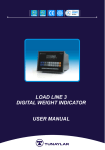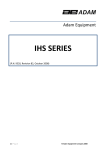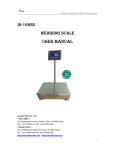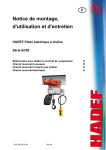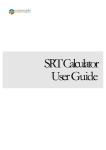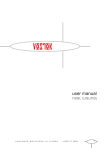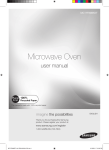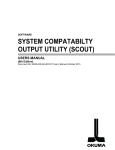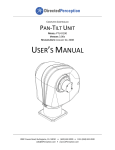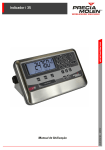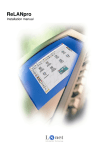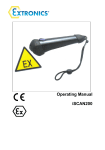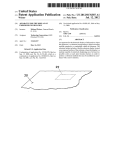Download Load Line 2 Weight Indicator User Manuel
Transcript
TYPE TEST OIML R76/EN45501 TYPE APPROVAL 90 / 384 / EEC Load Line 2 Weight Indicator User Manuel 3. SUBJECTS TO BE CONSIDERED DURING SETUP, OPERATING AND MAINTENANCE Mounting: ! The instrument is suitable for table or panel mounting (see drawings for details of different types). Please observe the Required environmental conditions as given in technical Specifications. Dismantling the Instrument: When removing the housing, covers or other protecting parts, live parts or terminals will be exposed. Therefore setting - up the instrument must be performed only by trained personnel who are aware of risks. Earthing: The instrument has to be earthed according to latest safety requlations which are valid locally. Electrostatically Sensitive Components: This instrument con tains electrostatically sensitive components. Therefore repair of electrostatically sensitive assemblies or Components must be carried out only by qualified personnel at workstations protected against electrostatic discharge. Other Instructions: * Check network voltage and especially protective earthing line before operating the terminal * Do not turn * Do not Disconnect load cell or serial port connectors while the indicator is operating, * In order to operate the indicator properly, it must be connected to a socket which have earthing, * Prevent device from direct * Do not make hard push to the buttons on the screwdriver or other sharp tools, * You can use little moist, soft and hairless gland in order to clean the device, * Prevent the device from water leaps. If water or any other liguid is spilled on the device, disconnect all of electricity connections and dry it. After being sure that the device is dried, you can start to operate it again. * Check the contents of the consignment for completeness and note whether any damage has occurred during transport. If the contents are incomplete, or if there is damage, immediately inform us in order to facilitate the repair or replacement of the instrument. on The indicator before load cell cable connector is connected. sunshine. Keep it away from heat sources (like stove), 8 keypad, do not use pencil, KM.LL2E.002 Parts provided with your device are as follows: - Load line-2 digital weight display (device itself) - Adaptor - MIC 6 Connector (for Load cell) - User Manual Additional for WT, WT-S Type : - PC Monitor - PC Keyboard - Mouse 9 KM.LL2E.002 FUNCTION F button is used to enter functions, Calibration and Set Up Menus. UPWARD It is used for strolling Upward Direction between progamming and calibration menus. DOWNWARD It is used for strolling Downward Direction between progamming band calibration menus. SET TO ZERO Zero button is used to make displayed weight value zero. In order to set weight to zero conditions given Below must be satisfied: F 0 § Weight display is in standstill condition § Tare is reset § Gross weight is in previously selected manual zero range § Indicator is not in set up mode, or in failure mode It is also used to move cursor left alphanumerical or numerical data entries. PRINT during Print button is used to print Weighing result Or save it Into alibi memory. (This button is disabled if continuous data transmit mode is active, please see the section for serial communication. Pressing to this button causes to print provided that: § Indicator' s manual transmit activated § The weight display is in standstill condition § Weight vaule is greater than min printable amount selected before not in set up mode, or in failure mode. 11 has correspondingly KM.LL2E.002 be ENTER Enter button is used to enter programming and calibration menus and to make selection among alternatives. It is also used as “Yes” button for question messages. ESC Esc button is used to go back to upper menus from sub menus. It can be used to exit without changing parameters. It is also used as cancel button for question messages. 4.3. Status Signals: STANDSTILL Standstill signal shows that the load on the platform does not move . It lights up as soon as “no motion” is anymore detected within the initially set range and time ( If the difference between consecutive weight values is smaller than the value selected in P2.7, then this signal will light after the time selected at P2.8 is elapsed). ZERO Zero signal shows that there is no load on the scale. It lights as soon as the actual gross weight is equal to zero. NET NET Net signal will light during net weight value is seen on display (lights up as soon as having tared by pressing tare or preset tare button). Pcs PIECES Pieces counting signal will light if pices counting function is activated. Lb POUND Lb signal will light if “ pound” is selected as weighing unit. KG Kg signal will light if “kilogram” is selected as weighing unit . 1 Range 1 This symbol shows 1st weighing range. If the weight is smaller than Max1 value, it will light. 2 Range 2 This symbol shows 2st weighing range. If the weight is greater than Max1 value, it will light. 0 12 KM.LL2E.002 5. CONFIGURATION AND CALIBRATION MENUS · In order to enter P1 - General, P2 - Parameters, P3 - Configuration and P4 - Calibration menus, calibration jumper must be closed. · Press F button to enter configuration is appeared, press Enter button, F · · After PASS ? message is displayed, write password and press Enter , (1) (3) T F You can use buttons in order to and · (5) (Order of keys starting from zero) stroll between main menus up, or down P2-PAR P2-PAR P1-GEN Use Enter button in order to enter sub menus of any of the main menus, P1.0 Again you can use and 1 buttons in order to stroll between sub menus, P1.0 P1.1 P1.1 P1.0 Press Enter button in order to start changing a parameter. Change it by using buttons and save it by pressing Enter button, P1.0 1 P1.0 · (2) P1-GEN P1-GEN · FUNC ? message FUNC ? PASS · and calibration menus, when 1 During data entry menus, left. and P1.0 1 P1.0 0 / buttons are used to move cursor one step rightor 0 00000 0 0 0 0000 0 0 0000 T 0 00000 13 KM.LL2E.002 · · And select the number which you want to write. 0 00000 0 1 0000 0 00000 0 9 0000 After changes are confirmed by enter button, menus from sub menus, P1.0 · u se Esc button to go back to main P1-GEN 0 In order to exit from programming and calibration menus, go to “End” menu and press Enter button, During SAVE ? message, press Enter button in order to save differences or use Esc button to exit without saving. - END - Calibration Sequence Summary: 1. Close calibration jumper J1 (for P1, P2, P3, P4) 2. Go through steps P1…P9 and select END 3. Open calibration jumper J1 4. Close and seal the weight indicator housing as described in this manual. 14 KM.LL2E.002 P1 GENERAL P2 PARAMETERS P3 CONFIGURATION P1.0 PURPOSE OF USE P2.0 AUTO ZERO TRACKING P3.0 CAPACITY 1 P1.1 SINGLE INTERVAL / MULTI RANGE / MULTI INTERVAL P2.1 AUTO ZERO TIME P3.1 DIVISION 1 P2.2 MANUAL ZERO P3.2 DECIMAL POINT PLACE 1 DEFAULT VALUES P2.3 INITIAL ZERO P3.3 CAPACITY 2 P2.4 LOAD CELL GAIN RATE P3.4 DIVISION 2 P2.5 ADC INTERVAL FILTER P3.5 DECIMAL POINT PLACE 2 P2.6 DIGITAL FILTER P3.6 WEIGHING UNIT P2.7 STANDSTILL DETECT INT. P3.7 DECIMAL POINT TYPE P2.8 STANDSTILL TIME P3.8 OVERLOAD P2.9 TARE ENABLE P1.2 P4 CALIBRATION P5 PORTS P6 INPUT / OUTPUT P4.0 WEIGHT CALIBRATION P5.0 ALIBI MEMORY P6.0 OUTPUT OPERATING TYPE P4.1 SELF CALIBRATION P5.1 BAUD RATE FOR COM 1-2 P6.1 OUTPUT ASSIGNING P4.2 GRAVITY PARAMETERS P5.2 BAUD RATE FOR COM 3 P6.2 OUTPUT SET WEIGHTS P5.3 CONTINOUS PORTS P6.3 INPUT OPERATING TYPE P5.4 MANUAL PORTS P5.5 SLAVE PORTS P5.6 ADDRESS P5.7 RS 422/485 PORTS P7 PERIPHERALS P8 ANALOG OUT P9 DISPLAY P7.0 MIN. LOAD FOR PRINTER P8.0 ENABLE / DISABLE P9.0 P7.1 TICKET FORMAT P8.1 RANGE INTERNAL COUNT DISPLAY TICKET FIELDS P8.2 TYPE P9.1 P7.2 CALIBRATION VALUE DISPLAY P7.3 TICKET LANGUAGE P8.3 MODE P7.4 PAPER TYPE P8.4 CALIBRATION - END - 15 KM.LL2E.002 5.1. P1-General: P1-GEN P2-PAR P1.0 P3-CON Single Interval P4-CAL P1.1 Multi Range Multi Interval P5-POR P1.2 P6-INO ------ P7-PRP P8-ANA P9-DIS -END- SYMBOL NAME ALTERNATIVES DEF. EXPLANATION P1.0 Purpose of Use 1 2 2 If non approved mode is selected, indicator adjustments can be changed without any restrictions. In approved mode, the data input will only be accepted if they are convenient to EN45501 standard. 0 You can select the operation type of the indicator from this menu. Select 0 for single Interval, 1 for Multi Range and 2 for Multi Interval. P1.1 P1.2 Non Approved Approved Single Interval 0 1 Multi Range Multi Interval 2 Default Values * ------- This option is used to return all of indicators parameters back to their factory default values. 16 KM.LL2E.002 * Factory default values are as follows: P6 – INPUTS / OUTPUTS P1 – GENERAL P6.0 P6.1 P6.2 P6.3 P6.4 P1.0 – 2 P1.1 – 0 P1.2 – - – – – – – 0 0 - P2 – PARAMETERS P2.0 P2.1 P2.2 P2.3 P2.4 P2.5 P2.6 P2.7 P2.8 P2.9 – – – – – – – – – – 0 4 1 0 64 0 5 1 2 0 P7 – PERIPHERAL EQUIPMENTS P7.0 P7.1 P7.2 P7.3 P7.4 – – – – – – – – – 0 0 0 P8 – ANALOG OUT P8.0 P8.1 P8.2 P8.3 P8.4 P3 – CONFIGURATION P3.0 P3.1 P3.2 P3.3 P3.4 P3.5 P3.6 P3.7 P3.8 – – – – – 1 0 1 0 1 1 2 – – – – – 0 0 0 - P9 – DISPLAY P9.0 – P9.1 – - P10 –END P4 – CALIBRATION P5.0 – P5.1 – P5.2 – P5 – PORTS P5.0 P5.1 P5.2 P5.3 P5.4 P5.5 P5.6 P5.7 – – – – – – – – 1 9600 9600 0 2 1 001 0 17 KM.LL2E.002 5.2. P2-Parameters: P2.0 P1-GEN P2.1 P2-PAR P2.2 P3-CON P2.3 P4-CAL P2.4 P5-POR P2.5 P6-INO P2.6 P7-PRP P8-ANA P2.7 P9-DIS P2.8 -END- P2.9 SYMBOL NAME ALTERNATIVES DEF. EXPLANATION P2.0 Auto Zero Tracking 0 Weight vaules smaller than the selected value will be set automatically to zero. P2.1 Auto Zero Waiting Time 4 Time which will be elapsed before auto zero is activated. P2.2 Manual Zero 1 Select max imum load range that can be manually zeroed by pushing zero button. P2.3 Initial Zero 0 1 2 3 4 5 6 7 8 0 1 2 3 4 1 2 3 0 1 2 3 4 0 Select range which will be start-up. - Disable 0.25e 0.5e 0.75e 1e 1.25e 1.5e 1.75e 2e 0 sec. 0,5 sec. 1 sec. 1,5 sec. 2 sec. %2 %20 full capacity Disable %1 %5 %10 %20 18 zeroed during KM.LL2E.002 P2.4 P2.5 Load Cell Gain Rate 1 2 4 8 16 32 64 x1 x2 x4 x8 x16 x32 x64 Select gain rate of load cells. 64 mV sig nal coming from Select 64 for 1 mV/V load cells, Select 64 or 32 for 2mV/V load cells, Select 64, 32 or 16 for others. 1, 2, 4 and 8 are dedicated for special applications. ADC Internal Filter 0 1 2 3 4 100 sps. 50 sps. 25 sps. 12.5 sps. 6.25 sps. 0 Select filter level against sudden impacts. Digital Filter 0 1 2 3 4 5 Disable Last 2 Last 4 Last 8 Last 16 Last 32 5 Select filter level. Moving average of last 2 32 weight vaules will be calculated. P2.7 Standstill Detection Interval If the difference between consecutive weight values is smaller than this value, standstill signal will light after the time period selected at P2.7 is elapsed. Standstill Waiting Time 2 Select time period will be elapsed before standstill signal lights ( if the consecutive weight values are smaller than P2.6). P2.9 Tare Request 1e 2e 3e 4e 5e 0 sec. 0,5 sec. 1 sec. 1,5 sec. 2 sec. Tare Enable Tare Disable 1 P2.8 1 2 3 4 5 0 1 2 3 4 0 1 0 Tare button can be enabled o r disabled. P2.6 19 KM.LL2E.002 5.3. P3-Configuration: P3.0 P1-GEN P3.1 P2-PAR P3.2 P3-CON P3.3 P4-CAL P3.4 P5-POR P3.5 P6-INO P3.6 P7-PRP P8-ANA P3.7 P9-DIS P3.8 -END- SYMBOL NAME ALTERNATIVES P3.0 Capacity 1 0000000 P3.1 Division Interval 1 (Verification Scale Interval) 1 2 3 4 5 6 7 8 9 0 1 2 3 4 1 2 5 10 20 50 100 200 500 No point xxxxx.x xxxx.xx xxx.xxx xx.xxxx P3.2 Decimal Point Place 1 P3.3 Capacity 2 0000000 P3.4 Division Interval 2 (Verification Scale Interval) P3.5 Decimal Point Place 2 1 2 3 4 5 6 7 8 9 0 1 2 3 4 1 2 5 10 20 50 100 200 500 No point xxxxx.x xxxx.xx xxx.xxx xx.xxxx DEF. EXPLANATION . Enter maximum capacity of the first weighing range (If single interval is selected at menu P4.1,this will be the Maximum Capacity of the scale) 1 Scale's division interval ( verification scale interval.) for weighing range 1. If P1.0 (purpose of use) is selected as approved, number of divisions can not exceed 3000. For non-approved applications you can select up to 50,000 divisions. 0 This option is to select place of decimal point for weighing range 1. Enter maximum capacity of the second weighing range 1 Scales division interval ( verification scale interval.) For weighing range 2. If P1.0 (purpose of use) is selected as approved, number of divisions can not exceed 3000. For non-approved applications you can select up to 50,000 divisions. 0 This option is to select place of decimal point for weighing range 2. 20 KM.LL2E.002 P3.6 unit 1 2 kg lb 1 Select weighing unit which will be displayed and printed on the ticket. P3.7 Decimal Sign Type Overload 1 2 0 1 2 3- point comma 0e 1e 9e %2 1 Select sign type (if decimal vaules are used). 2 Select overload value which can be displayed after full scale capacity. P3.8 21 KM.LL2E.002 5.4. P4-Calibration: No Load P4.0 Add Load P1-GEN P2-PAR Lc Cap P3-CON Lc Sens P4.1 No Load P4-CAL P5-POR Gr-Cal P4.2 P6-INO Gr-Use P7-PRP P8-ANA P9-DIS -END- SYMBOL NAME ALTERNATIVES P4.0 Calibration With Weight ------- DEF. EXPLANATION Note: Maximum capacity and and division interval values must be set before starting calibration process. After No Load message appears, make sure that scales platform is empty and press Enter button. Device will show “BUSY” message. “Add Load” message will appear. Put calibration weight on scales platform (min 10 % of full scale, preferably close to maximum capacity) and press Enter button. Then, write this calibration weight value via keypad and press Enter button. Device will display “ BUSY ” message again. After calibration is completed, main menu will be seen on display. After c alibration with weight process is implemented, gravity acceleration values will be zeroed. 22 KM.LL2E.002 P4.1 Self Calibration ------- This method is used to calibrate the device without calibrated weigh ts. You must enter number of load cells (Lc No), capacity of load cells (Lc Cap), mi llivolt signal (Lc Sens) and to let the device sense the dead load of the scale (No Load) . Finally press Enter button, device will show “BUSY” message. Note: self calibration can be used only for not legal for trade applications P4.2 Gravity Acceleration ------- Gravity acceleration parameters make it possible to compensate the weight difference between the place in which the instrument is calibrated (GR-CAL) and the place in which the instrument will be used (GR-USE), due to different gravity acceleration. Gravity acceleration values must be between 9,77000 and 9,84000 Enter these two parameters by using keypad (starting from left) and press enter button. After that, the weight calibration is automatically corrected. Gravity values at some places are as follows: Amsterdam Athens Auckland NZ Bangkok Birmingham Brussels Buenos Aires Calcutta Chicago Copenhagen Djakarta Frankfurt Glasgow Havana Helsinki Kuwait Lisbon London (Greenwich) Los Angeles Madrid 23 9.813 9.800 9.799 9.783 9.813 9.811 9.797 9.788 9.803 9.815 9.781 9.810 9.816 9.788 9.819 9.793 9.801 9.812 9.796 9.800 m/s 2 m/s2 m/s2 m/s2 m/s2 m/s2 m/s2 m/s2 m/s2 m/s2 m/s2 m/s2 m/s2 m/s2 m/s2 m/s2 m/s2 m/s2 m/s2 m/s2 KM.LL2E.002 5.5. P5-Ports : P1-GEN P2-PAR P3-CON P5.0 P4-CAL P5.1 P5-POR P5.2 P6-INO P5.3 P7-PRP P5.4 P8-ANA P5.5 P9-DIS P5.6 --- P5.7 -END- SYMBOL NAME ALTERNATIVES DEF. EXPLANATION P5.0 Alibi Memory 0 Disable 1 1 Enable Alibi memory can be enabled or disabled. Capacity of alibi memory is 105.000 records. When this capacity is exceeded, device will not send serial data until records in alibi memory is deleted. P5.1 Baud Rate for Ports 1 - 2 P5.2 Baud Rate for Port 3 P5.3 Ports for Continuous Data Transmit 300 9600 600 1200 2400 4800 9600 19200 38400 300 9600 600 1200 2400 4800 9600 19200 38400 0 Disable 0 1 Com 1 2 Com 2 3 Com 3 4 Com 1+2 5 Com 1 + 3 6 Com 2 + 3 7 Com 1 + 2 + 3 24 Select baud rate of communication Ports 1-2 Select baud rate of communication Port 3 Select port names for continuously transmitting data (data protocol is given in later sectons). KM.LL2E.002 SYMBOL NAME P5.4 Ports for Manual Data Transmit P5.5 Slave Ports P5.6 Address P5.7 RS 422 / 485 ALTERNATIVES 0 1 2 3 4 5 6 7 Disable Com 1 Com 2 Com 3 Com 1+2 Com 1 + 3 Com 2 + 3 Com 1 + 2 + 3 0 1 2 3 4 5 6 7 Disable Com 1 Com 2 Com 3 Com 1+2 Com 1 + 3 Com 2 + 3 Com 1 + 2 + 3 DEF. EXPLANATION 2 Select port names for manually transmitting data(data protocol is given in later sections). Alibi memory reports can be taken through this parts. 1 Device can be used as slave or master. Select port names which will be used as slave ports. (---) 001 0 1 2 3 0 Disable Com 2 Com 3 Com 2 + Com 3 25 Max. of 32. indicators can be connected. Enter. device's address information here. If this value is left as zero then the slave port will not work properly. Select port names for RS422/485 data communication. These ports are full duplex. KM.LL2E.002 5.6. P6-Inputs / Outputs: OP 1 P6.0 P1-GEN -----OP 4 P2-PAR OUT 1 P3-CON P6.1 P4-CAL -----OUT 4 P5-POR P6-INO SP 1 P7-PRP P6.2 ----- P8- ANA SP 4 P9-DIS P6.3 -END- P6.4 SYMBOL NAME P6.0 Output Operating Type ALTERNATIVES DEF. EXPLANATION 0 1 2 3 0 You can select operating type of outputs. Disable Net Values Brut Values Inputs each of If 0 (disable) is selected, relevant output will be disabled. If 1 (net) is selected, re spective output will be closed when net weight value is greater than set point weight (entered at P6.2). If 2 (brut) is selected, this time brut values will be compared with set point weights. If 3 (inputs) is selected, output will work with respect to inputs, meaning that if one of the inputs is active, then respective output will be active (you can assign different inputs to each of outputs as shown in P6.1). P6.1 Output Assign ------- You can assign different inputs to each of outputs. First of all s elect output number and press enter button. Then write respective in puts you want to assign by using the following formula: Input1 x 1 + Input2 Input4 x 8. 26 x 2 + Input3 x 4 + KM.LL2E.002 P6.1 Output Assign ------Press Enter button to go next one. You dont have to enter all of 4 outputs, you can exit at any time by using Esc button. Example: if output 1 is assigned to inputs 1 and 3, select output 1 (Out 1) and press enter button. Then write the result of following formula: 1x1 + 0x2 + 1x4 + 0x8 = 06 P6.2 Output Set Point Weights ------- You can define 4 different set point weights. Enter set weight values by using numerical buttons and then press Enter button to go next one. You dont have to enter all of 4 set values, you can exit at any time by using Esc button. Example: if displayed weight value (brut or net) is smaller than set point 1, output 1 will be open till it exceeds set point 1. As soon as weight value is greater than or equal to set point 1, output 1 is closed. P6.3 Input Operating Type 0 Disable 1 Standard 2 External Buttons 0 You can select operating type of the set point inputs. If 0 (disable) disabled. is selected, inputs will be If 1 (standard) is selected, inputs enabled. will be If 3 (external buttons) is selected, 1st in put will be used as tare button, 2nd input will be used as zero button and 3rd input will be used as print button. P6.4 Application Type 0 Filling 1 Level Measuring If 0 is selected , outputs will not be set while weight is returning back to zero un til zero is displayed. If 1 is selected , outputs will be set as soon as weight is smaller than related set point value. 27 KM.LL2E.002 5.7. P7-Peripheral Equipments: P7.0 P1-GEN P2-PAR TOP- - P3-CON P7.1 P4-CAL LEF - - BOT- - - P5-POR P7.2 P6-INO P7-PRP ------ P7.3 P8-ANA P7.4 P9-DIS -END- P7.5 SYMBOL NAME ALTERNATIVES DEF. EXPLANATION P7.0 Minimum Load for Printer 0 This value shows minimum weight value at which pinter outputs can be taken. P7.1 Ticket Format 0 0 1 20 e 2 50 e ----- Enter number of blank rows from top (Top), number of blank characters from left (left) and blank rows at the end (Bottom). Note: Each of above values must be between 1 to 255. P7.2 Ticket Fields ----- Fields on the ticket can be defined by using the following formula: Ticket no x 1 + Firm Name x 2 + Date-Time x 4 + Code x 8 + Weight x 16 + Barcode x 32. You must put 1 for the fields you want to include to the ticket, and put 0 for others. Then calculate above formula and enter it to P7.2 Example: If you want only ticket no and weight fiel ds on the ticket, then result of the formula will be equal to: 1x1 + 0x2 + 0x4 + 0x8 + 1x16 + 0x32 = 17. You must enter 17 28 KM.LL2E.002 SYMBOL NAME ALTERNATIVES DEF. EXPLANATION P7.3 Ticket Language 0 1 Turkish English 0 Select language which will be used to explain fields on ticket. P7.4 Ticket Paper Type 0 1 Standard Sticker 0 Select paper type. 29 KM.LL2E.002 5.8. P8-Analog : Out P8.0 P1-GEN P2-PAR P8.1 P3-CON ------ 0-20mA P4-CAL P8.2 P5-POR 4-20mA 0-10V P6-INO P7-PRP Brut P8-ANA P8.3 Net P9-DIS -END- P8.4 ------ SYMBOL NAME ALTERNATIVES DEF. EXPLANATION P8.0 Disable / Enable 0 1 0 You can enable or disable Analog Out. If Analog Out is enabled it works continously within the range given in P8.1 P8.1 Range --- - Select weight range in which analog out will work.Analog out will not be active if the current weight value is not in this range. (Min. and Max. Weight values) P8.2 Type 0 1 2 0 Select one of three analog out operating types.(0-20mA,4-20mA,0-10V) P8.3 Mode 0 1 0 Select work mode as Brut(0) or Net(1). P8.4 Calibration - This part is used to calibrate Analog Output. First enter zero value and then maximum value. Calibration will provide more accurate analog output value. --- 30 KM.LL2E.002 5.9. P9-Display: P1-GEN P2-PAR P3-CON P4-CAL P9.0 P5-POR P9.1 P6-INO P7-PRP P8-ANA P9-DISP -END- SYMBOL NAME ALTERNATIVES DEF. P9.0 Internal Count Display ----- You can change display type from weight display to in ternal count display by pressing Enter button at P9.0. Esc button can be used to exit. P9.1 Calibration Value Display ----- Calibration value shows number of internal counts per one v erification scale interval ( i.e. slope of calibration line). 31 EXPLANATION KM.LL2E.002 5.10. End : P1-GEN P2-PAR P3-CON P4-CAL ESC P5-POR EXIT WITHOUT SAVE SAVE ? P6-INO EXIT WITH SAVE P7-PRP P8-ANA P9-DIS -END- SYMBOL NAME -END- End (or Exit) ALTERNATIVES DEF. EXPLANATION In order to exit from programming and calibration menus, select End ? and press Enter button. Then Save ? message will appear, you can save changes permanently by pushing Enter button. 32 KM.LL2E.002 6. FUNCTIONS: F 0 Date F T Hour (Time) F Piece Counting F x10 Viewing F 0 Date DATE ? message will appear. Press enter button to see and change date (date format is: ddmmyy) F Time HOUR ? message will appear. Press enter button to see and change time (time format is: hh mm) F Piece Counting First of all put a few of items you wa nt to count on the scale and select this function. COUNTIN? message will appear. Press Enter button and write number of pieces on the scale, then press enter button again . Number of pieces will be seen on display and pcs signal will light. Now you can pu t all of items you want to count. Use Esc button in order to exit from this function. F x10 Viewing message will appear. If you press Enter button Ent 10? verification scale interval will be divided by 10 and device will be 10 times more sensitive. X10 viewing will last 5 seconds. T 33 KM.LL2E.002 7. ALIBI MEMORY : F 0 All Weighing Records F T Delete Records in Alibi Memory F F 0 T All Weighing Records "ALL" message will be seen, you can print all weighing records by pushing enter button. You can exit by pushing Esc button. Deleting Weighing Records DELETE ? message will appear. If you press Enter button all of weighing records in the alibi memory will be printed and deleted. Serial number (ticket number) will also be zeroed. You must clean alibi memory if maximum capacity is reached, otherwise device will not send data to serial port. You can exit without deleting records by pushing Esc button. Standard Report Example : 010104 10:20 ALL RECORDS S.NO BRUT TARE 000001 13000kg 2000kg 000002 15000kg 5000kg 000003 17000kg ..... NET 11000kg 10000kg 34 KM.LL2E.002 8. SERIAL COMMUNICATION PROTOCOL 8.1. Continuous Data Transmit: Each package has 21 byte s and starts with Chr(2) and ends up with Chr(13). Serial data baud rate is adjustable between 300, 600, 1200, 2400, 4800, 9600, 19200, 38400. Data length is 8 bits and there is no parity . Data will be sent only after standstill condition is reached. Order of bytes in each package is as follows : SB A B C SP WEIGHT 1 SB: Start Byte (1 Byte) Chr (2) A: Status Word (1 Byte) A.0: A.1: A.2: A.3: A.4: A.5: A.6: A.7: B: CH CK ST Always 1 1 for Net 1 for Preset Tare 1 for Zero Not used Always 1 1 for Negative Not Used Always 1 1 for manual print Always 0 Always 0 Always 1 Always 1 Always 0 Always 0 Status Word 3 (1 Byte) C=0: C=1: C=2: C=3: C=4: SP: WEIGHT 2 Status Word 2 (1 Byte) B.0: B.1: B.2: B.3: B.4: B.5: B.6: B.7: C: SP If If If If If there there there there there is no decimal point is 1 character after point are 2 characters after point are 3 characters after point are 4 characters after point Space (1 Byte) WEIGHT 1: Displayed Weight Value (6 Byte) B6 MSB B5 B4 B2 B1 B0 LSB 35 KM.LL2E.002 WEIGHT 2: Tare Weight (6 Byte) B6 B5 B4 B2 B1 MSB B0 LSB CH: Character (1 Byte) Chr (3) CK: Checksum (1 Byte) ASCII totals of bytes between SB and CH (with respect to Mod 256) ST: Stop Byte (1 Byte) Chr (13) 36 KM.LL2E.002 8.2. Manual Data Transmit: Standard Data Transmit Shape 1 (Gross Weight): Ticket No: N Date D6 O : SP SP SP SP SP D6 D5 D4 D3 D2 D1 CH / D4 D3 / D2 D1 SP SP SP D4 D3 : D2 D1 CH I G H T : SP D6 D5 D4 D3 D2 D1 SP D2 D1 Time: D5 Weight: W E CH Standard Data Transmit Shape 2 (Net Weight): Ticket No: N Date D6 O : SP SP SP SP SP D6 D5 D4 D3 D2 D1 CH D4 D3 / D2 D1 SP SP SP D4 D3 : D2 D1 CH U T : SP SP SP D6 D5 D4 D3 D2 D1 SP D2 D1 CH R E : SP SP SP D6 D5 D4 D3 D2 D1 SP D2 D1 CH T : SP SP SP SP D6 D5 D4 D3 D2 D1 SP D2 D1 CH Time: D5 / Gross Weight: B R Tare Weight: T A Net Weight: N E 37 KM.LL2E.002 SP: CH: Space chr (13) D6, D5, D4, D3, D2, D1: Data Standard Ticket Examples: NO: 000250 01/01/2004 BRUT: NO: 000250 16:15 00250.5 kg Standard Transmit Shape 1 01/01/2004 16:15 BRUT: 00250.5 kg TARE: 00100.0 kg NET: 00350.5 kg Standard Transmit Shape 2 Note: You can modify or change t icket format by using parameters at P7-PRP menu. 38 KM.LL2E.002 8.3. Master - Slave Communication : If the ports are configured in slave mode two way and full duplex communication is possible. To do that, first of all each weight indicator must be addressed. In order to take data from Slave ports the following characters must be send to the indicator. SB + Address + ST SB : Start Byte Address : 1 Byte (Address Info) ST : Stop Byte As soon as the indicator take these bytes it will send data to master device via the ports which are dedicated as slave. This communication can be done through RS 232 or RS 422/485. It is possible to connect up to 32 indicators. Data structure is as follows : SB + Address + Record No + Date + Time + Weight + CK + ST SB : Start Byte Address : 1 Byte (Address Info) Record No : D6 D5 D4 D3 D2 D1 Date : D6 D5 / D4 D3 Time : D4 D3 : D2 D1 Weight : D6 D5 D4 D3 D2 D1 CK : Checksum ST : Stop Byte / D1 D2 39 KM.LL3E.001 9. ERROR MESSAGES Error 1 ADC Conversion Error Restart the device and call our firm if error message appears again Error 2 Signal Failure Signals are oppositely connected. . Correctit. Error 3 Weak Signal Check calibration parameters (especially P3.8) and steel construction of the scale. Error 4 Division Number Error Check maximum intervals. Error 5 Initialization Error Restart device. Be sure that load is still while the device is opening. Error 6 Calibration Weight Error Calibration Weight must be greater than or equal to 5% of maximum capacity. Error 7 Parameter Error Check all parameters. Error 8 Incorrect Calibration Password Check your calibration password and then try again. Error 10 Calibration jumper does not exist Attach calibration jumper. C alibration jumper must be attached in order to enter some of programming and calibration parameters. Error 11 Date Check date and time parameters. Time Error 40 capacity and verification scale KM.LL2E.002 Error 12 Serial Port Selection Error Ports selected for continuous and manual data transmit must not be the same. Error 13 Linearization Correction Error Difference between manually entered value and displayed weight value must be smaller than +-2% of displayed value. Error 14 No Load Cell There is no mV signal coming to the device, check load cell connection. Note: If you meet with one of error messages given above, please implement relevant instructions or call one of our authorized services. 41 KM.LL2E.002 42 0 VDC 1 2 NC RTS / RS485 RX+ CTS / RS485 RX- 6 7 8 NC GND RS485 TX- RS485 TX+ 14 15 RS485 RX- RS485 RX+ 12 13 GND 11 TX OUT / RS485 TX+ 4 ANALOG OUT 10 RX IN/ RS485 TX- 5 MEANING A GND OUT 9 NC PIN RX2 IN / CTS 8 9 NC TX2 OUT / RTS 7 MEANING NC 6 1 NC GND 4 TX1 OUT RX1 IN NC MEANING 5 1 PIN COM1/2 SERIAL PORT / RS 232 PIN COM3 SERIAL PORT / RS 422 / 485 - RS 232 ANOLOG OUTPUT +12 VDC 1 MEANING PIN SUPPLY 0 VDC INPUT 2 D INPUT 3 C INPUT 3 D INPUT 4 C INPUT 4 D BODY COM OUT2 B OPTIC/RELAIS OUT3 A OPTIC/RELAIS COM OUT3 B OPTIC/RELAIS OUT4 A OPTIC/RELAIS COM OUT4 B OPTIC/RELAIS +12 VDC IPUT VOLTAGE FOR INPUT ............................. C + 5 VDC D 0 VDC MAX CURRENT FOR INPUT ........................... 5 mA MAX LIMIT FOR RELAIS OUTPUT ..................... 1 A MAX LIMIT FOR OPTIC OUTPUT ................... 300 mA INPUT 2 C INPUT 1 C OUT2 A OPTIC/RELAIS COM MEANING INPUT 1 D OUT1 A OPTIC/RELAIS 1 2 PIN COM 1/ 2 ( DB9 MALE ) COM 3 ( DB15 MALE ) LOAD-CELL ( MIC 6 ) OUT1 B OPTIC/RELAIS MEANING I/O ( DB25 MALE ) PIN I/O SUPPLY ( MIC 3 ) CLOSED - NETWORK OPEN - FULL DUBLEX J10 and J11 CLOSED - HALF DUBLEX J7 and J8 - SIGNAL + SENS TYPE . LL2 CTA-CTB-CTC - SUPPLY / - SENSE - SIGNAL + SIGNAL + SUPPLY / + SENSE LOAD-CELL CABLE CONNECTOR(4WIRE) LOAD-CELL CABLE CONNECTION(6WIRE) RS 485 JUMPER SETTING + SENS MEANING J7 and J8 6 5 4 3 2 1 PIN NO LOAD-CELL 3 10. CABLE CONNECTIONS (TYPE CTA-CTC-CTB) KM.LL2E.002 0 VDC 2 43 CTS / RS485 RX- 8 15 RS485 TX+ INPUT 1 D INPUT 2 C INPUT 2 D OUT1 B OPTIC/RELAIS OUT2 A OPTIC/RELAIS COM NC TX2 OUT/ RTS RX2 IN / CTS NC 7 8 9 GND 5 6 NC 4 D 0 VDC MAX CURRENT FOR INPUT ........................... 5 mA MAX LIMIT FOR RELAIS OUTPUT ..................... 1 A MAX LIMIT FOR OPTIC OUTPUT ................... 300 mA BODY TX1 OUT +12 VDC - - OUT4 B OPTIC/RELAIS - OUT3 B OPTIC/RELAIS COM INPUT 4 D COM OUT4 A OPTIC/RELAIS INPUT 3 D INPUT 4 C OUT3 A OPTIC/RELAIS INPUT 3 C OUT2 B OPTIC/RELAIS IPUT VOLTAGE FOR INPUT ............................. C + 5 VDC NC 1 INPUT 1 C COM 0 VDC 2 MEANING MEANING PIN USB S-Video RCA/SPDIF COM1 OUT1 A OPTIC/RELAIS VGA Out Parellel (LPT1) 1 PS2_KB LAN RJ45 PIN I/O POWER SWITCH PS2_MS RX1 IN MEANING PIN COM1/2 SERIAL PORT / RS 232 RTS / RS485 RX+ RS485 TX- 7 RS485 RX+ 14 NC 13 GND 6 RS485 RX- 12 5 GND 11 TX OUT / RS485 TX+ NC ANALOG OUT 10 RX IN/ RS485 TX- 4 A GND OUT 9 NC 1 MEANING PIN MEANING PIN COM3 SERIAL PORT / RS 422 / 485 - RS 232 ANOLOG OUTPUT +12 VDC 1 1 MEANING PIN SUPPLY SUPPLY ( MIC 3 ) Line-In Microphone Line-Out LOAD-CELL J10 and J11 J7 and J8 CLOSED - NETWORK OPEN - FULL DUBLEX CLOSED - HALF DUBLEX RS 485 JUMPER SETTING J7 and J8 6 5 - SIGNAL TYPE . LL2 WT-WTS - SUPPLY / - SENSE - SIGNAL + SUPPLY / + SENSE + SIGNAL + SENS CABLE CONNECTION(6WIRE) CABLE CONNECTOR(4WIRE) LOAD-CELL 3 4 + SENS MEANING LOAD-CELL ( MIC 6 ) 3 2 1 PIN NO LOAD-CELL COM 1/2 ( DB9 MALE ) COM 3 ( DB15 MALE ) I/O ( DB25 MALE ) 10. CABLE CONNECTIONS (TYPE WT, WT-S) KM.LL2E.002 10.1 Load Cell Connection : 1 2 3 6 5 4 The load cell cable must not be channelled with other cables (i.e. outputs connected to remote switches or power supply wires), but must follow its own route. Any cable extensions must be carefully shielded, respecting the colour codes and using the same type of wire as that supplied by the manufacturer. The extension connections must be soldered or connected through support terminal blocks or the joint block supplied separately. The load cell wire must not have more conductors than those effectively used (4 or 6). In the case of a 6-conductor wire, of which only 4 are used ( excitation + and - , signal + and -), connect the sense + and -wires to the respective polarities of the excitation wires. A maximum of eight 350- ohm load cells can be connected to the instrument in parallel. The load cell excitation voltage is 5 Vdc and is protected against a temporary short circuit. 6 Wire: PIN NO DESCRIPTION 1 2 3 4 5 6 SHLD + SUPPLY + SENSE + SIGNAL - SIGNAL - SENSE - SUPPLY BODY CABLE CONNECTION + SUPPLY + SENSE + SIGNAL - SIGNAL - SENSE - SUPPLY BODY SIGNAL - CABLE CONNECTION + SUPPLY / + SENSE + SIGNAL - SIGNAL - SENSE / - SUPPLY BODY SIGNAL - EXCITATION + SENSE + SIGNAL + SENSE EXCITATION - 4 Wire: PIN NO DESCRIPTION 1 2 3 4 5 6 SHLD + SUPPLY + SENSE + SIGNAL - SIGNAL - SENSE - SUPPLY BODY 44 EXCITATION + SIGNAL + EXCITATION - KM.LL2E.002 10.2 Serial Connections : In order to create the serial connection use a shielded cable, making sure that only one of the two shield ends is grounded. If the cable has more conductors than those used, connect the free conductors to the shield. The serial connection wire must be a maximum of 15 metres long ( EIA RS-232-C standards), in addition to which it is necessary to adopt the Rs422 interface th at the instrument can be equipped with. The cable must not be channelled with other cables (i.e. outputs connected to remote switches or power supply wires), but must follow its own route. The PC used for the connection must conform to the EN 60950 standa rd. 1 5 6 9 Com 1/2: (RS 232) PIN NO 2 3 5 SHLD 7 8 DESCRIPTION RXD TXD GND BODY RTS / TX 2 CTS / RX 2 COM1: LOAD LINE-2 LOAD LINE-2 2 3 3 2 5 5 7 7 8 8 9 Pin 9 Pin 2 2 3 3 5 7 7 4 8 5 9 Pin PC, PRINTER, ETC. PC, PRINTER, ETC. 25 Pin COM2: LOAD LINE-2 8 3 7 2 5 5 9 Pin LOAD LINE-2 45 9 Pin 8 2 7 3 5 7 9 Pin PC, PRINTER, ETC. PC, PRINTER, ETC. 25 Pin KM.LL2E.002 Com 3: (RS 422/485 - RS 232) 1 COM3: 8 LOAD LINE-2 9 15 PIN NO 1 2 3 4 5 6 7 8 SHLD DESCRIPTION NC RX IN TX OUT NC GND NC RTS CTS BODY LOAD LINE-2 2 3 3 2 5 5 7 7 8 8 15 Pin 9 Pin 2 2 3 3 5 7 7 4 8 5 15 Pin PC, PRINTER, ETC. PC, PRINTER, ETC. 25 Pin 10.3 COM3 (RS422/485) Serial Connection : - The serial connection cable must be suitable for Rs485 serial communications, with two twisted pairs and relative protective shielding. - The cable must not be channelled with other cables (i.e. outputs connected to remote switches or power supply wires), but must follow its own route. - The PC used for the connection must conform to the EN 60950 standard. Com 3: (RS 422/485) 1 PIN NO 12 13 14 15 SHLD Com 3: (RS 422/485 Optional) 2 DESCRIPTION RS485 RXRS485 RX+ RS485 TXRS485 TX+ BODY PIN NO 2 3 7 8 SHLD DESCRIPTION RS485 TXRS485 TX+ RS485 RX+ RS485 RXBODY 10.4 Analog Ouput (Optional) : (DB 15 MALE) PIN NO 9 10 SHLD DESCRIPTION A GND OUT ANALOG OUT BODY 46 KM.LL2E.002 10.5 Inputs / Outputs 1 13 25 14 PIN NO 1 2 3 4 5 6 7 8 9 10 11 12 13 DESCRIPTION OUT 1A COM OUT 1B OUT 2A COM OUT 2B OUT 3A COM OUT 3B OUT 4A COM OUT 4B +12VDC PIN NO 14 15 16 17 18 19 20 21 22 23 24 25 SHLD DESCRIPTION 0VDC INPUT 1C INPUT 1D INPUT 2C INPUT 2D INPUT 3C INPUT 3D INPUT 4C INPUT 4D BODY 15 Inputs: The logic inputs are electrically isolated from the instrument through opto-isolators. - Use the shortest possible connection wire. 16 The inputs are active when a voltage of 5 Vdc is applied (PNP logic). 17 In order to activate a logic input, it is necessary to close the relative terminal supplied by external power. 18 - +5 V - +5 V 19 20 - +5 V 21 22 47 - +5 V KM.LL2E.002 Outputs: 1 The logic outputs are electrically isolated from the instrument through opto - isolators. 3 2 The logic outputs are provided on a 4 relays, the rate of each contact is 1A/24Vdc or 0.5A / 125 Vac. Each output is free programmable. - + TRANSISTOR OUTPUT RELAIS OUTPUT 4 6 5 - + TRANSISTOR OUTPUT RELAIS OUTPUT 7 9 8 - + RELAIS OUTPUT TRANSISTOR OUTPUT 10 12 11 TRANSISTOR OUTPUT 48 + RELAIS OUTPUT KM.LL2E.002 10.6 Power Supply 1 2 3 PIN NO 1 2 DESCRIPTION +12VDC 0 VDC The power supply wire must be grounded and must be channelled separately from other supply wires with different voltages, from the load cell wires and the logic input/output wires. Supply voltage: 12VDC ~ 50/60 Hz The instrume nt is grounded for practical reasons, ground protection. 49 therefore check the presence of valid KM.LL2E.002 11 . DRAWINGS & SEALING PLANS 50 KM.LL2E.002 I /O ( DB 2 5 MALE ) LOAD-C E LL ( MIC 6 ) S UP P LY ( MIC 3 ) C OM 3 ( DB 1 5 MALE ) C OM 1 / C OM 2 ( DB 9 MALE ) TY P E IP 65 I /O ( DB 2 5 MALE ) LOAD-C E LL ( MIC 6 ) S UP P LY ( MIC 3 ) OR C OM 1 / C OM 2 ( DB 9 MALE ) VE R IF IC ATION P LATE P R OTE C TION S E ALS LE AD TY P E IP 65 I /O ( DB 2 5 MALE ) C OM 3 ( DB 1 5 MALE ) OR C OM 3 ( DB 1 5 MALE ) S UP P LY ( MIC 3 ) LOAD-C E LL ( MIC 6 ) C OM 1 / C OM 2 ( DB 9 MALE ) VE R IF IC ATION P LATE XX XX XXXX XXXX P R OTE C TION S E ALS LE AD P R OTE C TION S E ALS ADHE S IVE LAB E L 51 P R OTE C TION S E ALS ADHE S IVE LAB E L KM.LL2E.002 52 KM.LL2E.002 53 KM.LL2E.002 KM.LL2E.003























































